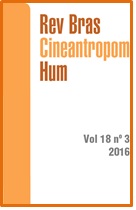Comparação entre dois modelos de treinamento sobre o gasto energético de repouso e a composição corporal de adolescentes com obesidade
DOI:
https://doi.org/10.1590/1980-0037.2016v18n3p268Resumo
Diferentes tipos de programas de exercícios físicos têm sido utilizados na tentativa de melhorar a composição corporal e aumentar o gasto energético de repouso (GER) de adolescentes obesos. O objetivo foi comparar os efeitos de dois modelos de treinamento sobre o gasto energético de repouso e a composição corporal de adolescentes com obesidade. Participaram do estudo vinte adolescentes obesos do sexo masculino, foram divididos de forma aleatória em dois modelos de treinamento: treinamento contra resistência (n=8, idade=13,4±1,0) e treinamento funcional (n=12, idade= 13,0±1,1). As variáveis de composição corporal foram estimadas pela densitometria radiológica de dupla energia. O GER foi realizado por meio da calorimetria indireta usando o equipamento QUARK-PFT (COSMED, Roma, Itália). O protocolo de treinamento consistiu de 30 minutos de treino aeróbio seguidos de 30 minutos de treino contra resistência (TC)ou funcional (TF), ambos durante 20 semanas. Não houve diferenças significantes entre os dois modelos de treinamento na composição corporal (massa gorda, TF= -7,6±5,5% x TC= -8,9±6,2%; p=0,620), (massa corporal magra, TF= 9,0±5,3% x TC= 6,8±6,7%; p=0,431) e no GER (TF= 19,6±15,3% x TC= 10,7±24,5%; p=0,331). Além disso, a massa corporal magra (p=0,01) e massa gorda (p=0,01) influenciam o GER. Não há diferença entre os dois modelos de treinamento, porém ambos são eficazes na redução da composição corporal e aumento do GER de adolescentes obesos. Adicionalmente, foi verificada a importância do treinamento físico sistematizado, uma vez que a massa corporal magra e massa gorda contribuíram para o aumento do GER após o treinamento.
Downloads
Publicado
Edição
Seção
Licença

Direitos Autorais para artigos publicados nesta revista são do autor, com direitos de primeira publicação para a revista. Em virtude da aparecerem nesta revista de acesso público, os artigos são de uso gratuito, com atribuições próprias, em aplicações educacionais e não-comerciais, desde que seja dada a atribuição. Esta obra foi licenciada com uma Licença Creative Commons Atribuição 4.0 Internacional - CC BY


